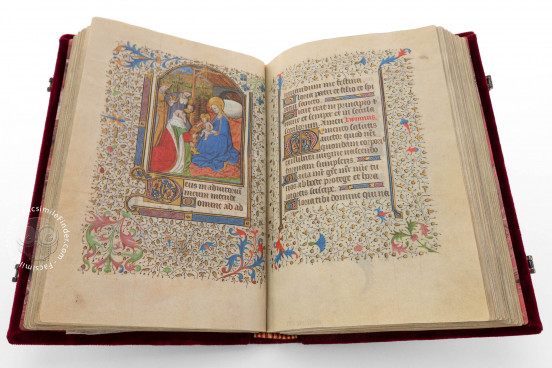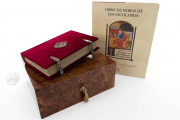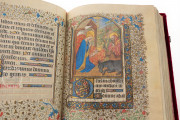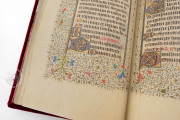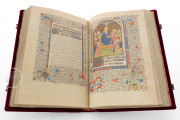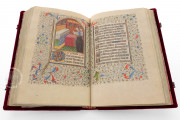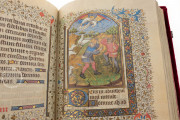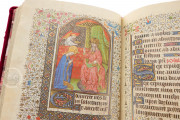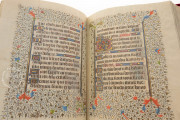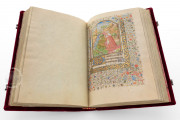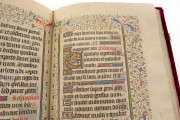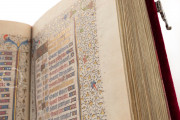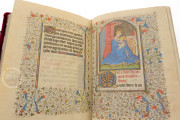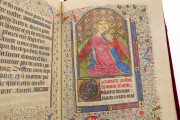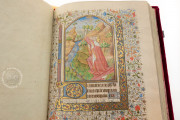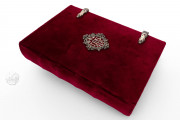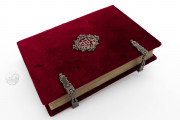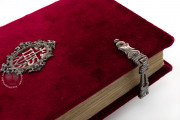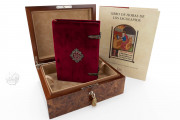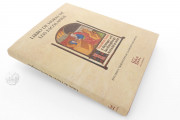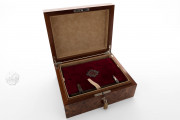A book for Christian private devotions, the Piarist Hours is a compilation of texts in Latin and French (including a calendar, Gospel excerpts, and the Hours of the Virgin) that comprise the customary contents of a book of hours. It was created in the first half of the fifteenth century probably in Paris, with illumination by the workshop of the Bedford Master. Each page's text or text and image are surrounded by a painted border. Most of those borders feature multi-color bars out of which sprout filigree tendrils of ivy leaves interspersed with colorful fleshy fronds, blossoms, and fruits. The manuscript boasts nineteen large miniatures, each introducing a new section of text.
The miniatures all follow the arch-topped format found in books of hours originating from the workshops of the Rohan Master, Bedford Master, and Boucicaut Master. They are in the International Style of the period around 1400, with the scenes set in delicate, deep landscapes or on sparkling diaper-pattern backgrounds.
Made for a Woman
A compelling detail is found in the miniature of the Presentation in the Temple in which the woman accompanying the Virgin is wearing a stylish contemporary dress and elegant headgear (fol. 62v), perhaps picturing the book's patron. The texts of some of the prayers indicate that the supplicant is female, and the manuscript is believed to have been made for a wealthy, cultured woman.
Painted by a Team
The manuscript's illumination is the work of at least three illuminators. The most accomplished artist painted the portraits of Saints John and Luke, the Annunciation to the Virgin, the Vigil for the Dead, and the Nursing Virgin. He also may have collaborated with others, painting only the figure of the Virgin Mary in the scenes of Nativity and the Adoration of the Magi (fols. 46r and 57v).
The Artist at Work
The portrait of Saint Luke the Evangelist (fol. 15r) shows the saint in the process of painting a bust of the Virgin Mary. The palette he holds in his hand is delightfully dotted with the colors of the miniaturist.
Gold on Every Page
The text, written in Gothic Textualis, features an abundance of painted initials of varying sizes. With gold in the rinceaux border of every page, it is clear that no expense was spared in the manuscript's creation.
Preserved in Spain
Although the manuscript's path to the Iberian Peninsula is unknown, the Piarist Hours has been in Spain since at least the eighteenth century. According to the history written at the beginning of the codex, the manuscript belonged to Tomás Crespo Agüero (1668-1742), Archbishop of Zaragoza and supporter of the Piarist school there. After passing through various hands, the book reached Juan Antonio de Rosillo, who donated it to the Colegio Escuelas Pías in Zaragoza in 1867.
We have 1 facsimile edition of the manuscript "Piarist Hours": Libro de Horas de los Escolapios facsimile edition, published by Siloé, arte y bibliofilia, 2007
Request Info / Price
